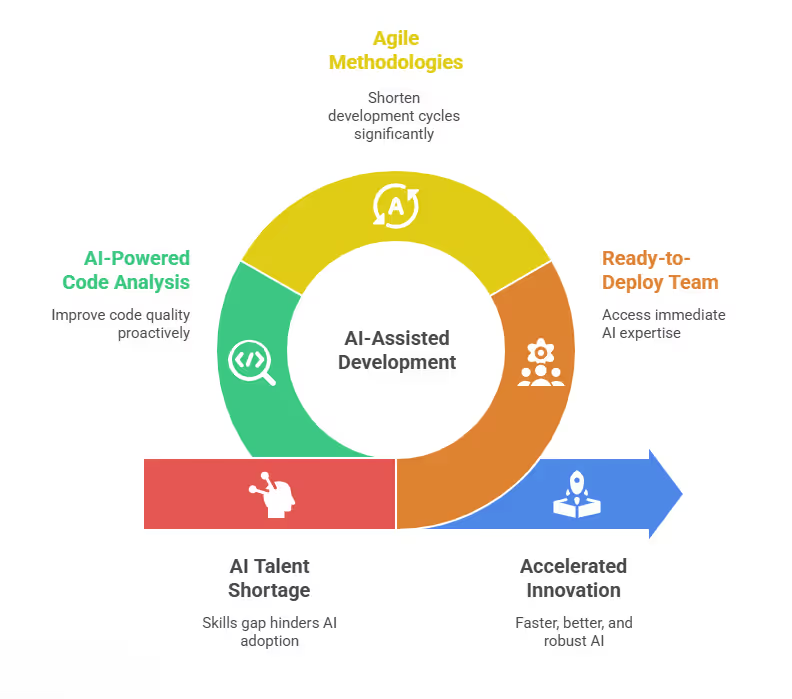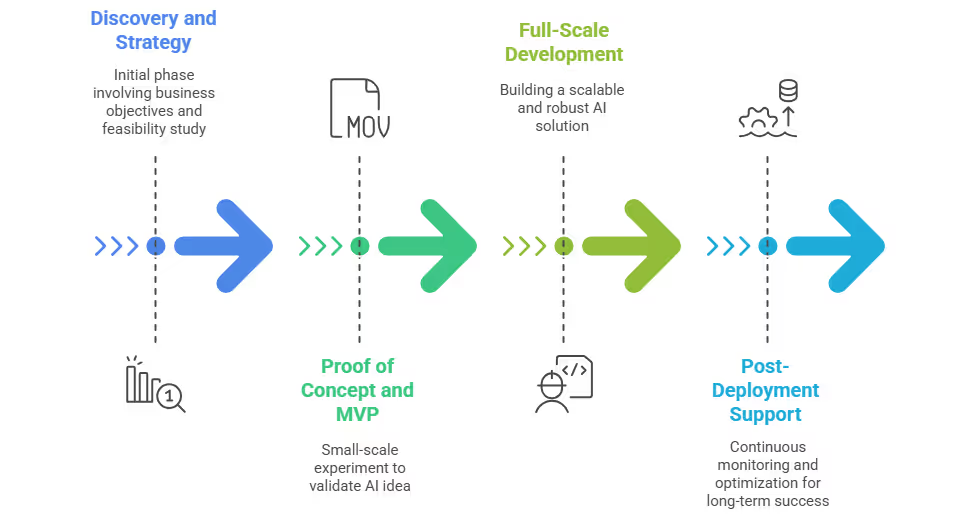AI Assisted Software Development – Upgrade Your Development Process

In the fast-evolving landscape of American innovation, a significant challenge persists: many artificial intelligence projects struggle to move beyond initial pilots. Industry reports often suggest that a considerable percentage of AI initiatives do not achieve their full potential, leading to wasted resources and delayed progress for U.S. companies. As an AI development company operating in the U.S. for over a decade, we have seen firsthand that successful AI integration often depends on a skilled and strategic AI-assisted development partner.
AI-assisted software development boosts productivity with tools like GitHub Copilot and Niral AI for code generation and autocompletion. AI automates QA testing, creating test cases and detecting defects efficiently. It analyzes requirements using NLP to align code with project goals. Integrate AI into IDEs and CI/CD pipelines to streamline workflows.
Our experience working with businesses across diverse sectors, from manufacturing in the Midwest to technology firms on the West Coast, demonstrates the profound impact of well-executed AI solutions in reshaping operations and market leadership for American businesses.
An AI-assisted Software development partner accelerates innovation for U.S. businesses, improving efficiency and reducing project risks.
How AI-Assisted Development Transforms U.S. Business Operations

AI offers immense opportunities for efficiency, deep insights, and breakthrough innovation. However, turning this promise into reality demands navigating a complex technological environment. Many American businesses, from small to medium-sized enterprises (SMBs) to large corporations with extensive legacy systems, find building in-house AI expertise from scratch to be a formidable task.
This is precisely where an AI-assisted development partner becomes an indispensable asset.
Bridging the AI Talent Gap in the U.S.
- A major challenge for American businesses embarking on AI journeys is the acute shortage of specialized AI talent. Reports from leading organizations, such as insights shared by McKinsey & Company, consistently highlight this skills gap.
- A strong AI-assisted development partner provides a ready-to-deploy team of data scientists, AI engineers, and machine learning specialists.
- This immediate access to deep expertise helps bypass lengthy recruitment cycles and the high overheads associated with building an internal AI division.
- For instance, a financial services firm in New York looking to implement predictive analytics for risk assessment can leverage a partner's established team, allowing them to focus on core business operations.
Accelerating Time-to-Market for U.S. Innovation
- In the intensely competitive U.S. market, speed to market is paramount. AI-assisted development partners utilize agile methodologies and advanced tools to significantly shorten development cycles.
- They can rapidly generate prototypes, develop minimum viable products (MVPs), and iterate based on real-world feedback. Consider an e-commerce company in California aiming to launch a personalized recommendation engine.
- An experienced partner can often develop and deploy this solution in a fraction of the time an in-house team might require, providing a clear competitive advantage.
- This acceleration extends beyond initial deployment, as partners can implement continuous integration and delivery (CI/CD) pipelines for ongoing AI model updates and improvements.
Enhancing Code Quality and Reducing Technical Debt
- AI tools, when integrated effectively, can fundamentally improve code quality.
- AI-assisted development partners are adept at implementing tools for automated code reviews, bug detection, and code refactoring.
- This ensures that the AI solutions built are robust, scalable, and maintainable. In a recent project with a major U.S. logistics company, the use of AI-powered code analysis helped identify and resolve numerous inefficiencies in their existing optimization software, leading to cleaner code and fewer operational errors.
- This proactive approach to quality assurance significantly reduces long-term technical debt.
Real-World Impact: Case Studies from the U.S. AI Landscape
To truly understand the value an AI-assisted development partner brings, it is helpful to look at real-world examples from the U.S. technology sector. These cases highlight common challenges faced by American businesses and how strategic AI partnerships provide effective solutions.
Case Study 1: Improving Customer Service for a Major U.S. Service Provider
A leading telecommunications company in the Northeast faced challenges with high call volumes and prolonged resolution times, impacting customer satisfaction. We partnered with them to deploy an AI-powered conversational chatbot and virtual assistant. The chatbot was trained using extensive customer interaction data.
- Result: The AI assistant now handles a significant portion of routine customer inquiries, from basic billing questions to technical troubleshooting, improving first-contact resolution rates. Human agents are freed to address more complex issues, leading to reductions in average call handling time and an improvement in customer satisfaction scores across their U.S. operations. This project showcased the effectiveness of AI integration services in streamlining customer support.
Case Study 2: Optimizing Supply Chain for a National Retail Chain
A prominent U.S. retail chain faced complexities in optimizing their vast supply chain, leading to inventory discrepancies and inefficient logistics. Our team developed custom AI solutions for demand forecasting and predictive maintenance of their warehouse equipment.
- Result: The AI-driven demand forecasting model, leveraging historical sales data and other relevant indicators, improved forecast accuracy. This led to reductions in both overstock and stockouts across their American distribution centers. The predictive maintenance system, monitoring sensor data from machinery, reduced equipment downtime, saving significant maintenance costs. This demonstrates the power of custom AI solutions for American businesses in logistics.
Case Study 3: Enhancing Cybersecurity for a U.S. Tech Company
A fast-growing tech startup in Silicon Valley, handling sensitive user data, needed to bolster its cybersecurity posture against increasingly sophisticated threats. We implemented AI-driven anomaly detection and threat intelligence systems.
- Result: The AI system continuously monitors network traffic and user behavior, identifying suspicious patterns indicative of potential cyberattacks in real-time. This led to faster detection of potential breaches and a reduction in false positives compared to their previous rule-based systems. This highlights the vital role of AI in safeguarding American digital assets.
Navigating Your AI Partnership: A Proven Four-Phase Framework
Our experience across numerous AI projects has consistently shown that a structured, phased approach is key to achieving successful AI-assisted development.
This framework minimizes risk and maximizes value for U.S. businesses.

Phase 1: Discovery and Strategy (AI Consulting)
This initial phase involves a deep dive into your business objectives, current infrastructure, and pain points. As an AI developing company, we engage in comprehensive AI consulting, asking critical questions:
- What specific problems do you aim to solve with AI?
- What data do you have available, and what is its quality?
- What are your key performance indicators (KPIs) for success?
- What is your risk tolerance and budget?
This phase often includes a feasibility study, identifying the most impactful AI opportunities and crafting a clear roadmap. For American companies, this means considering relevant regulatory landscapes and specific market dynamics.
Phase 2: Proof of Concept (PoC) and Minimum Viable Product (MVP) Development
Instead of immediately committing to a large-scale deployment, a responsible partner will recommend starting with a Proof of Concept (PoC) or Minimum Viable Product (MVP).
- PoC: A small-scale experiment designed to validate the technical feasibility of an AI idea.
- MVP: A functional version of the AI solution with core features, designed to gather early user feedback and demonstrate tangible value. This allows for quick wins and helps de-risk larger investments. Many U.S. startups leverage MVPs to validate their concepts and secure further funding.
Phase 3: Full-Scale AI Solution Development and Seamless Integration
Once the PoC or MVP confirms viability and delivers measurable value, the full-scale development phase commences. This involves:
- Model Training and Refinement: Iteratively training and optimizing AI models with larger, more diverse datasets.
- System Architecture Design: Building a scalable and robust architecture for the AI solution that integrates seamlessly with existing enterprise systems.
- Deployment and Testing: Rigorous testing in various environments (staging, production) to ensure performance, accuracy, and security. This often includes stress testing for peak load performance relevant to typical American user demands.
- User Interface (UI) / User Experience (UX) Development: Ensuring the AI solution is user-friendly and intuitive for both employees and customers.
Phase 4: Post-Deployment Support, Monitoring, and Optimization
AI is not a "deploy and forget" technology. Continuous monitoring and optimization are critical for long-term success and maintaining the initial value.
An effective AI development company provides:
- Performance Monitoring: Tracking key metrics such as model accuracy, latency, and resource utilization.
- Model Retraining and Updates: Regularly retraining models with new data to prevent performance degradation and adapt to changing conditions.
- Troubleshooting and Maintenance: Addressing any issues that arise and ensuring the system operates smoothly.
- Scalability Planning: Proactively preparing the AI solution to handle increasing data volumes and user loads.

